This article relies largely or entirely on a single source .(May 2018) |
| |||
|---|---|---|---|
| +... |
| Years in film |
|---|
 |
| 19th century |
| 1870s |
The following is an overview of the events of 1889 in film, including a list of films released and notable births.
This article relies largely or entirely on a single source .(May 2018) |
| |||
|---|---|---|---|
| +... |
| Years in film |
|---|
 |
| 19th century |
| 1870s |
The following is an overview of the events of 1889 in film, including a list of films released and notable births.
| Month | Date | Name | Country | Profession | Died | |
| January | 23 | Franklin Pangborn | US | Actor | 1958 | |
| February | 3 | Carl Theodor Dreyer | Denmark | Director | 1968 | |
| 4 | Walter Catlett | US | Actor, Comedian | 1960 | ||
| 6 | Herbert Hübner | Germany | Actor | 1972 | ||
| 8 | Siegfried Kracauer | Germany | Critic, Journalist | 1966 | ||
| 22 | Joseph Egger | Austria | Actor | 1966 | ||
| 23 | Musidora | France | Actress, screenwriter, director | 1957 | ||
| 23 | Victor Fleming | US | Director, cinematographer | 1949 | ||
| March | 28 | Lola Braccini | Italy | Actress | 1969 | |
| April | 16 | Charlie Chaplin | UK | Actor, filmmaker | 1977 [1] | |
| 14 | James Stephenson | UK | Actor | 1941 | ||
| 26 | Anita Loos | US | Writer, producer | 1981 | ||
| 28 | Bryant Washburn | US | Actor | 1963 | ||
| May | 3 | Beulah Bondi | US | Actress | 1981 | |
| 5 | Harry Woods | US | Actor | 1968 | ||
| 20 | Karin Molander | Sweden | Actress | 1978 | ||
| 31 | Athene Seyler | UK | Actress | 1990 | ||
| June | 11 | Wesley Ruggles | US | Director, producer | 1972 | |
| 15 | Marjorie Rambeau | US | Actress | 1970 | ||
| July | 8 | Eugene Pallette | US | Actor | 1954 | |
| 16 | Larry Semon | US | Actor, screenwriter, director, producer | 1978 | ||
| 27 | Vera Karalli | Russia | Actress, Ballerina | 1972 | ||
| August | 8 | Hans Egede Budtz | Denmark | Actor | 1968 | |
| 24 | Tom London | US | Actor | 1963 | ||
| October | 3 | Alan Dinehart | US | Actor | 1944 | |
| 12 | Victor Potel | US | Actor | 1947 | ||
| 13 | Douglass Dumbrille | Canada | Actor | 1974 | ||
| November | 10 | Claude Rains | UK | Actor | 1967 | |
| 19 | Clifton Webb | US | Actor | 1966 | ||

The Lumière brothers, Auguste Marie Louis Nicolas Lumière and Louis Jean Lumière, were French manufacturers of photography equipment, best known for their Cinématographe motion picture system and the short films they produced between 1895 and 1905, which places them among the earliest filmmakers.
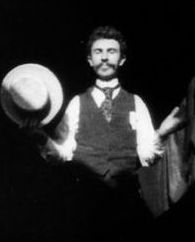
William Kennedy Laurie Dickson was a British inventor who devised an early motion picture camera under the employment of Thomas Edison.
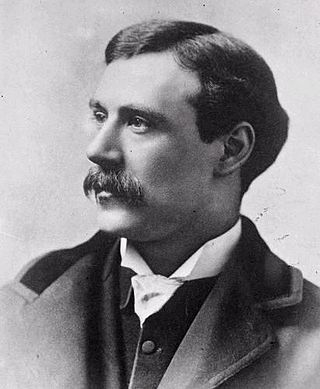
William Friese-Greene was a prolific English inventor and professional photographer. He was known as a pioneer in the field of motion pictures, having devised a series of cameras between 1888–1891 and shot moving pictures with them in London. He went on to patent an early two-colour filming process in 1905. Wealth came with inventions in printing, including phototypesetting and a method of printing without ink, and from a chain of photographic studios. However, Friese-Greene spent all his money on inventing, went bankrupt three times, was jailed once, and died in poverty.

Richard Marius Joseph Greene was a noted English film and television actor. A matinée idol who appeared in more than 40 films, he was perhaps best known for the lead role in the long-running British TV series The Adventures of Robin Hood, which ran for 143 episodes from 1955 to 1959.
Celluloids are a class of materials produced by mixing nitrocellulose and camphor, often with added dyes and other agents. Once much more common for its use as photographic film before the advent of safer methods, celluloid's common contemporary uses are for manufacturing table tennis balls, musical instruments, combs, office equipment, fountain pen bodies, and guitar picks.
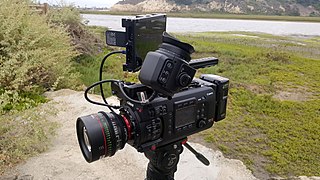
A movie camera is a type of photographic camera that rapidly takes a sequence of photographs, either onto film stock or an image sensor, in order to produce a moving image to display on a screen. In contrast to the still camera, which captures a single image at a time, the movie camera takes a series of images by way of an intermittent mechanism or by electronic means; each image is a frame of film or video. The frames are projected through a movie projector or a video projector at a specific frame rate to show the moving picture. When projected at a high enough frame rate, the persistence of vision allows the eyes and brain of the viewer to merge the separate frames into a continuous moving picture.

The Kinetoscope is an early motion picture exhibition device, designed for films to be viewed by one person at a time through a peephole viewer window. The Kinetoscope was not a movie projector, but it introduced the basic approach that would become the standard for all cinematic projection before the advent of video: it created the illusion of movement by conveying a strip of perforated film bearing sequential images over a light source with a high-speed shutter. First described in conceptual terms by U.S. inventor Thomas Edison in 1888, it was largely developed by his employee William Kennedy Laurie Dickson between 1889 and 1892. Dickson and his team at the Edison lab in New Jersey also devised the Kinetograph, an innovative motion picture camera with rapid intermittent, or stop-and-go, film movement, to photograph movies for in-house experiments and, eventually, commercial Kinetoscope presentations.

Louis Aimé Augustin Le Prince was a French artist and the inventor of an early motion-picture camera, possibly the first person to shoot a moving picture sequence using a single lens camera and a strip of (paper) film. He has been credited as the "Father of Cinematography", but his work did not influence the commercial development of cinema—owing largely to the events surrounding his 1890 disappearance.
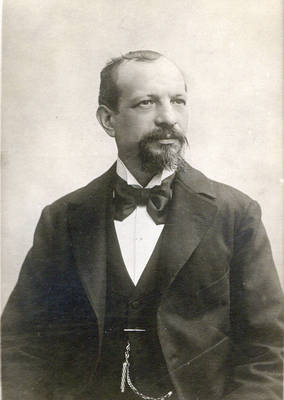
Eugène Augustin Lauste was a French inventor instrumental in the technological development of the history of cinema.
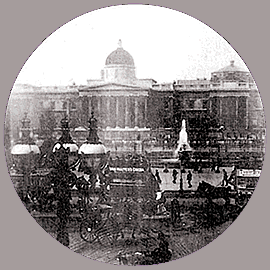
The following is an overview of the events of 1890 in film, including a list of films released and notable births and deaths.

The Magic Box is a 1951 British Technicolor biographical drama film directed by John Boulting. The film stars Robert Donat as William Friese-Greene, with numerous cameo appearances by performers such as Peter Ustinov and Laurence Olivier. It was produced by Ronald Neame and distributed by British Lion Film Corporation.
Claude Friese-Greene was a British-born cinema technician, filmmaker and cinematographer, most famous for his 1926 collection of films entitled The Open Road.

Monkeyshines is a series of experimental short silent films made to test the original cylinder format of the Kinetoscope, and are believed to be the first films shot in the United States.
The decade of the 1880s in film involved significant events.
The decade of the 1890s in film involved some significant events.

Leisurely Pedestrians, Open Topped Buses and Hansom Cabs with Trotting Horses is a 1889 British short silent actuality film, shot by inventor and film pioneer William Friese-Greene. The film depicts life at Hyde Park Corner in London. Hyde Park Corner is claimed to be the first film set in London, as well as the first to be filmed on celluloid, although Louis Le Prince successfully shot on glass plate before 18 August 1887, and on paper negative in October 1888. It may nonetheless be the first moving picture film on celluloid and the first shot in London. It was shown mainly to several photographic journalists who saw it during his lifetime—including Thomas Bedding, J. Hay Taylor and Theodore Brown. It is now considered a lost film with only 6 possible frames surviving today.
The Lost World of Friese-Greene is a BBC documentary series produced in conjunction with the British Film Institute. Three one-hour episodes were broadcast on BBC Two in spring 2006.
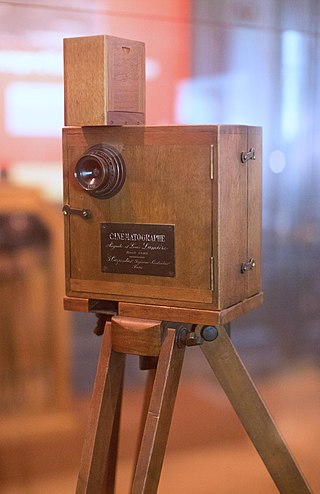
The history of film technology traces the development of techniques for the recording, construction and presentation of motion pictures. When the film medium came about in the 19th century, there already was a centuries old tradition of screening moving images through shadow play and the magic lantern that were very popular with audiences in many parts of the world. Especially the magic lantern influenced much of the projection technology, exhibition practices and cultural implementation of film. Between 1825 and 1840, the relevant technologies of stroboscopic animation, photography and stereoscopy were introduced. For much of the rest of the century, many engineers and inventors tried to combine all these new technologies and the much older technique of projection to create a complete illusion or a complete documentation of reality. Colour photography was usually included in these ambitions and the introduction of the phonograph in 1877 seemed to promise the addition of synchronized sound recordings. Between 1887 and 1894, the first successful short cinematographic presentations were established. The biggest popular breakthrough of the technology came in 1895 with the first projected movies that lasted longer than 10 seconds. During the first years after this breakthrough, most motion pictures lasted about 50 seconds, lacked synchronized sound and natural colour, and were mainly exhibited as novelty attractions. In the first decades of the 20th century, movies grew much longer and the medium quickly developed into one of the most important tools of communication and entertainment. The breakthrough of synchronized sound occurred at the end of the 1920s and that of full color motion picture film in the 1930s. By the start of the 21st century, physical film stock was being replaced with digital film technologies at both ends of the production chain by digital image sensors and projectors.
Arthur Albert 'Esme' Collings was an English photographer, miniaturist and the first of the loose association of early film pioneers dubbed the Brighton School by French film historian Georges Sadoul. Collings, whose interest in cinematography may have stemmed from his business association with fellow film pioneer William Friese-Greene, was only active in film production for about a year, has left little trace and is, according to film historian Rachael Low, of local importance only.